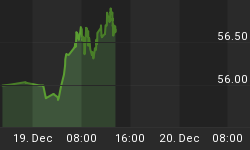Europe Matters
With no clear winner in the recent Italian elections, the financial markets may now have reason to worry looking out several weeks. From the Wall Street Journal:
Italy's political parties began testing the waters Tuesday to see whether they could cobble together a government, as the prospect of political stalemate sent European markets tumbling in fear of a reawakened euro-zone debt crisis.
Testing Important Support
Like nature, financial markets seem to follow symmetrical patterns. The three parallel trendlines shown below are one example. The slopes of the last three weekly advances have been similar. When the weekly advances broke the upward sloping trendlines near points A & B, multi-week corrections in stocks followed. Therefore, the trendline on the right side of the chart remains important for both bulls and bears.

If we take a closer look at the same trendlines on a daily chart, we see several areas where support held (above green arrows). However, the upper trendline was recently broken and acted as resistance below the red arrow, which is not what stock market bulls want to see. If markets are able to bounce between Wednesday and Friday, the dotted-horizontal lines show levels of possible resistance (areas where sellers may step in). A move on the S&P 500 back to the 1500-1515 range is well within reason, even under a correction scenario.

Sequester Meeting Sparks Rally
The catalyst for Wednesday's rally was news our friends in Washington, D.C. are having a little get together. From MarketWatch:
President Barack Obama and congressional leaders are preparing for a Friday meeting about the automatic budget cuts known as the sequester, on the same day that those across-the-board spending reductions are set to take effect.
Counting Rabbits
The Fibonacci sequence is named after Leonardo of Pisa, who was known as Fibonacci. In the process of finding the Fibonacci numbers, he considered the growth of an idealized rabbit population. Traders track Fibonacci retracement levels since markets often find support at these logical levels.
The chart below shows retracement levels based on the move from the October 2011 low to the recent 2013 high. In this case, we have used the highest intraday high and lowest intraday low. Should markets correct further, the areas of possible support come in near 1356, 1301, and 1250.

The chart below shows retracement levels based on the move from the November 2012 low to the recent 2013 high. In this case, we have used the highest intraday high and lowest intraday low. Should markets correct further, the areas of possible Fibonacci support come in near 1460, 1437, and 1416. The highs of 1474 and 1464 are also noteworthy.

The chart below shows retracement levels based on the move from the November 2012 low to the recent 2013 high (right side of chart). The left side of the chart shows retracement levels based on the move from the June 2012 low to the recent 2013 high. In this case, we have used closing prices. Should markets correct further, the areas of possible Fibonacci support come in near 1463, 1442, 1434, 1421, 1404, and 1375.

What Goes Up...
One of the reasons we booked profits well before this week's 27 point plunge in the S&P 500 was "vertical chart syndrome". We noted in a January 25 article:
As markets begin to advance in a near-vertical manner, it becomes more and more difficult to manage risk. Charts that "go straight up" can also "come straight down".
Below is an updated version of one of the charts we used as an example of a "vertical market". When we posted the original chart on January 25, OIH closed at 43.14. The vertical chart did "come down" recently making an intraday low of 41.40.

Bad Breadth
This week's plunge in stocks has been foreshadowed for weeks. The McClellan Summation Index is a market breadth indicator that is derived from the number of advancing and declining stocks in a given market. The concept of breadth is easy to understand; healthy markets have broad participation during rallies. As shown in the chart below, when the Summation Index begins to roll over, the odds of a stock market pullback increase. The S&P 500 is shown at the bottom of the chart.

We referenced the chart above on February 6 citing it a "yellow flag" for stock investors. We have also "tweeted" (@CiovaccoCapital) the chart numerous times in the past month or so. Since February 6, the S&P 500 moved from 1512 to the recent intraday low of 1485.















